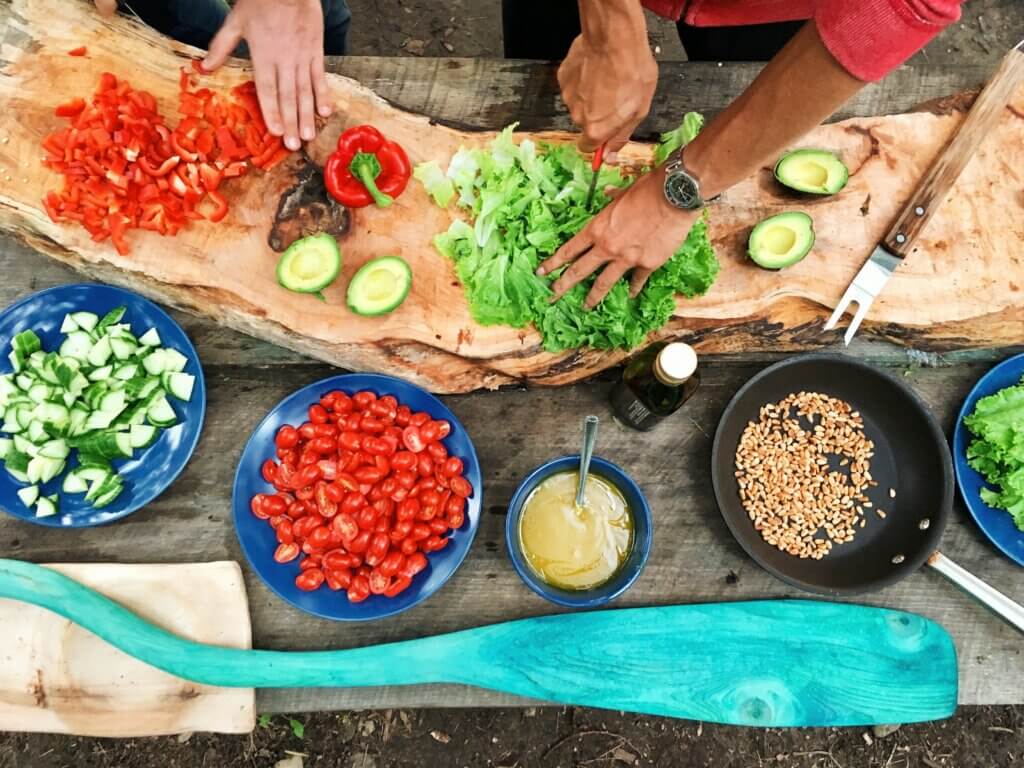
By Victoria Wallace
On Survivor, the long-running reality TV show that sends Americans to remote beaches to compete for $1 million, contestants are periodically divided over the fate of a chicken. While the gritty realities of survival are featured less on the show than social and physical competition, enough poultry-based drama makes it onto the screen for trends to emerge.
Subsisting mostly on a meager diet of white rice, winning teams on the show are often rewarded with live chickens—and the subsequent dilemma of what to do with them. Typically, utilitarian teammates assign themselves the role of butcher, while their squeamish counterparts look away. In season 2, experienced hunter Michael Skupin leads the debate over the chickens’ fate. The sole dissenter, Kimmi Kappenburg, leaves camp, while Skupin and fellow contestant Rodger Bingham team up to do the deed with “just a hatchet and a block of wood.”
Kappenburg isn’t alone in her discomfort about killing birds on reality television. The intimacy and violence of killing chickens on Survivor has continued to ruffle feathers, on-screen and at home. Perhaps most notably, season 12’s gentle-spirited Tai Trang successfully advocated for a rooster named Mark, intermittently charming and annoying teammates with his do-no-harm philosophy. On season 38, California resident Wendy Diaz infamously hatched a plot to free her team’s birds, while controversially admitting she has no qualms about eating factory farmed chickens at home.

Chicken-related squabbles on Survivor illustrate a widely observed feature ofindustrialized society: a profound separation between meat-eaters and the animals sustaining them. Cows, as a concept, do not often appear in the imagination of someone eating a Totino’s pepperoni pizza roll.
The consequence of our estrangement from farm animals is that people in rich countries are eating more meat than ever before. But this level of meat consumption is untenable. If every human being ate the same amount of meat as the average Briton, 95% of habitable land on Earth would be needed for agriculture. If everyone ate as much as an American (over 200 pounds of meat per year on average), agriculture would occupy 178% of global land—literally, more land than exists on this planet.
Advocates of climate justice know that radical change is needed, that modern lifestyles are impractical and unsustainable. Unfortunately, this earthshattering realization is rarely accompanied by a clear path forward. What does sustainable meat consumption look like?
Ancient humans were hunter-gatherers, careful observers and managers of local ecosystems. Around 9,000 – 10,500 years ago, people started to keep herds of livestock for consumption—beginning with sheep, goats, cattle, and pigs. For the first time, humans owned animals. Hunting strategies were replaced by concerns over the wellbeing of the herd. “Domestication,” anthropologist Brian Fagan writes, “means a shift in focus from the dead animal to the living one.”
Flocks and herds were small and closely managed. Sustainability was central to subsistence herding; an oversized herd would quickly overgraze and destroy good pastureland. During the day, animals would be driven to pasture and vigilantly guarded from predators. In the evening, they would be kept near or even inside human settlements. Herders would have recognized each animal individually, carefully selecting breeding pairs.
The investment in breeding, rearing, and managing livestock put a high value on meat consumption. The slaughter of animals was often ritualized, imbued with spiritual and social significance. Large, communal feasts were common in a world without modern refrigeration and preservation technology.
As cities grew and technology evolved, livestock became a commodity. Individual animals were valued at a price per unit, rather than their significance to the health of the herd. Agricultural intensification and mass production further reduced the cost of meat. Now, you can pay less for a Quarter Pounder than certain brands of bottled water. As our lives become further removed from the lives of the animals we eat, we seem to value them less.
The devaluation of animals and their meat is accompanied by the rise in factory farming, which obscures the realities of meat production. From birth until death, we almost never lay eyes on the creatures we eat. The diversity of animal life on Earth is somewhat misrepresented by depictions of polar bears in the Arctic, giraffes on the scrubby savannah, and toucans gracing the branches of tropical rainforests. It is estimated that 96% of mammals on Earth are humans and livestock, and 70% of birds are poultry. We live on a meat planet.
It’s clear that we meat-eaters must eat less meat if humans are to survive and thrive on this planet. But, instead of eating less meat out of disgust or despair — what if it came from a place of reverence? Our predecessors, who lived alongside the animals they ate, held them in high esteem. Livestock were killed for cyclical feasts and gatherings. Meat was celebrated, never taken for granted.
Of course, there are practical reasons why we might not all immediately adopt the meat-eating habits of a subsistence herder. Wherever you are, you might consider these ways to move toward a (more) plant-based diet:
- Start small. If you eat meat every day, try Meatless Mondays. If you eat meat three times a week, you might aim for twice a week.
- Think about enjoying meat at celebrations, and sticking to a mostly-plant diet on normal days.
- A rule of thumb is that four-legged animals (pigs, beef, and sheep) are worse for the planet than two-legged animals (turkey and chicken) or no-legged animals (fish and shellfish). If you can’t skip meat, opt for two legs or no legs.
- Most of us were raised on meat-based meals. Get comfortable making a few meat-free recipes you love, so cooking meat-free is just as easy as an old family recipe.
- Keep an eye out for plant-based substitutes for eggs and dairy.
- It’s harder to change your habits alone. Make plans with likeminded friends to share recipes, eat at a vegetarian restaurant, or cook together.
